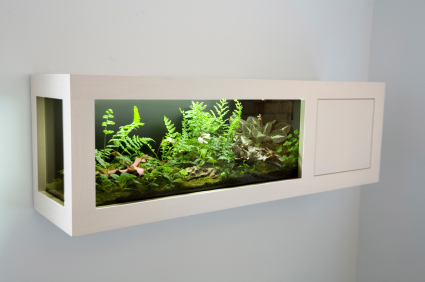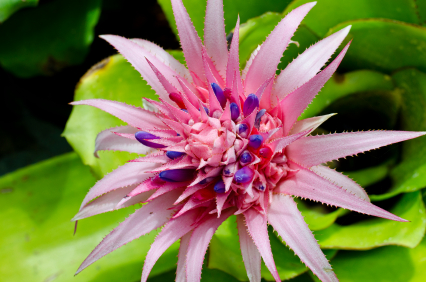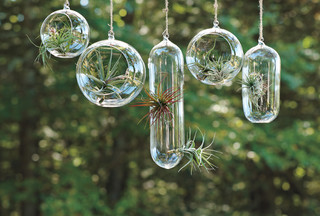How to Plant a Bromeliad Terrarium
Author: Melanie Dearringer2 Comments
Care and Culture, Growing Indoors

An advantage to growing bromeliads is their ability to be displayed using a variety of unique methods. One method of growing and displaying bromeliads is a terrarium. Bromeliads are well suited to growing in terrariums because of their love of humidity and small root systems.
Types of Terrariums
Terrariums were initally introduced as Wardian cases. Botanist, Dr. Ward, began using these decorative glass cases for displaying exotic tropical plants. He found them helpful in preserving rare plants as he brought them by ship to Europe. They became common throughout Europe during the 19th century. Wardian cases can still be used to grow bromeliads today. Terrariums have evolved into variety of forms including anything from tiny glass ornaments to very large aquarium tanks.
A true terrarium is an enclosed glass case that houses a miniature ecosystem. There is enough water in the closed glass system that it creates its own water cycle. Most bromeliads require air circulation and would rot in the very wet conditions found in a true terrarium. Fortunately, open terrariums and vented terrariums are also very common and ideal for bromeliads.

-A Terrarium can be a great addition to a home or office.
Most bromeliads thrive on high levels of humidity and bright indirect light. The glass enclosure of a terrarium easily retains moisture creating the ideal environment for may bromeliad species. Many terrariums that are housed in aquarium tanks also have built in supplemental lighting. This makes it easy to ensure the bromeliads receive enough light to thrive. Terrariums can also be used to house frogs and other small aquatic creatures. Bromeliads with water holding tanks are excellent habitat for these creatures.
Getting Started
There are some bromeliads that will grow better in terrariums than others. It is always important to consider the size of the plant and ensure that the care needs of all of the plants in the terrarium are similar. While moist, humid terrariums are very common, terrariums can also be crafted to mimic arid climates.
To get started decide what type of terrarium you want. Something as simple as hurricane glass or a small fishbowl will work. You can also use a much larger aquarium tank. Next, place a layer of pebbles in the bottom of the terrarium. Then cover the pebbles with activated charcoal. Mix some charcoal in with potting soil and place it in the terrarium to the desired height. Add the plants and then pack soil around them pressing tight to remove air pockets. Dress the top of the soil with moss. If you are using all mounted plants you do not have to use potting soil. Simply layer pebbles and activated charcoal using moss to decorate as desired. Terrestrial bromeliads planted in potting soil are best used in terrariums that are not entirely enclosed. Air circulation is needed to prevent the plants from rotting. Instead of an open terrarium you can also attach a fan to an aquarium lid to ensure the soil will not remain constantly soaking wet.
Bromeliad Varieties
Once you have chosen your terrarium, choose a few plants that will fit the size, style and moisture content of the terrarium. There are several genera of bromeliads that are more appropriate for growing in a terrarium than others. These genera include Neoregelias, Cryptanthus, Aechmea, Vriseas, Bilbergia and Tillandsia. Plants that have many rosettes or leaf axils for storing water are especially desirable for terrariums that will remain moist.
Cryptanthus
Cryptanthus is a genus of terrestrial bromeliads. They grow low to the ground forming beautiful star shapes with their leaves. They tolerate constantly moist soil and prefer high humidity making them ideal for growing in terrariums. Cryptanthus beuckeri and its hybrids are great in terrariums because they prefer low light levels and humid environments. Cryptanthus bivittatus also makes a wonderful terrarium candidate because of its small size and unique foliage. Cryptanthus fosterianus is also a stunning plant that you may want to consider for your terrarium.
Tillandsia
Tillandsias must be mounted when used in a terrarium. Not all Tillandsias will thrive in a terrarium because they need to dry regularly and require plenty of air movement. Be warned that you should avoid using Tillandsias with grey scales. These Tillandsias are adapted to arid climates and will not survive the moisture found in terrariums. However, if you have a very open terrarium or a terrarium fitted with a fan you can be more liberal when selecting Tillandsias. Tillandsia stricta is an excellent terrarium plant.
Neoregelia
Neoregelias are particularly known for their foliage. There are many species and cultivars that come in a wide range of colors and shapes. The rosettes of Neoregelias hold a substantial amount of water and are therefore especially helpful in terrariums that house frogs. Neoregelia ‘Echo’, offers a beautiful orange color and the ability to hold a lot of water. Neoregelia compacta has an attractive bright red center with green tips and is a perfect size for most terrariums.
Aechmea and more
Aechmea are urn shaped plants. Their foliage typically extends upward and collects water in the leaf axils. Aechmea ‘Suenos’ grows only 6 inches tall and has lovely purple inflorescence. Aechmea organensis (small form) is also ideal for its compact size and medium light requirements. Bilbergias and Vrieseas are similar to Aechmeas in their general form and care requirements.

– Aechmea can grow in terrariums
Except for Cryptanthus all of these species are epiphytic. They should be mounted on a substrate if they are intended for a very moist terrarium where the potting medium will remain constantly wet. They can also be left in small plastic grow pots and placed in the terrarium. The grow pots can be easily covered with rocks or moss. Using the grow pots will allow the potting medium to drain and they can be individually monitored to ensure they do not remain constantly wet. Aechmeas, Bilbergias, Neoregelias and Vrieseas can all be placed directly in the potting medium if the terrarium is very open allowing the potting medium to dry between watering.
An Example
One example of a Wardian case comes from The Rainforest Garden. The article suggests using fir bark as a potting medium along with pebbles as a base, followed by activated charcoal and moss in the bottom of the Wardian case. Planted in the fir bark are several Aechmeas and Neoregelias. Then added were a few Tillandsias mounted on a piece of driftwood. The case will require occasional misting and allows air to flow through easily.
Troubleshooting
Once you have constructed your terrarium keep a close eye on the individual plants. When the plants appear too dry a misting may be necessary. When the potting media remains too wet you may need to find a way to encourage drainage, more ventilation and potentially remove the plants that are at risk of rotting. It is also not necessary to use fertilizer. The bromeliads may be a bit slower growing as a result, but because there are no drainage holes the fertilizer residue will build up in the terrarium. It is especially important to refrain from fertilizers if your terrarium also houses living animals.
Terrariums are an attractive way to display bromeliads. They are fun to design because choosing the terrarium and selecting and arranging plants require creativity. They are also easy to care for, making them ideal for a home or office.
What bromeliads have you used in terrariums? Have you faced any challenges with growing bromeliads in terrariums?
Sources
“A Guide to Terrarium Plants” GlassTropics. <http://glasstropics.com/content/guide-popular-terrarium-plants>
“How to Grow Cryptanthus.” The Cryptanthus Society. <http://fcbs.org/cryptanthussociety/CS_CultureSheet.pdf>
“How to Plant A Terrarium.” The Rainforest Garden. <http://www.therainforestgarden.com/2011/04/how-to-plant-terrarium.html>
“Top Plants for Terrariums.” Better Homes and Gardens. <http://www.bhg.com/gardening/houseplants/projects/top-plants-for-terrariums/#page=4>
“Tropiflora Care for Bromeliads in the Terrarium and Vivarium.” Tropiflora. <http://tropiflora.safenetserver.com/files/Terrarium%20Brom%20Care.pdf?CFID=5469085&CFTOKEN=4460933296082f8a-C8416755-F275-9B05-6BCA6F30A9F2554C&jsessionid=843030ba362e144debc72c5a3f132537e764>
“Wardian Case” Wikipedia. <http://en.wikipedia.org/wiki/Wardian_Case>
Contemporary Spaces by Brooklyn Furniture & Furniture via http://www.houzz.com/professionals/furniture-and-accessories/c/Brooklyn–NY
Tillandsia terrarium photo credit: amy.gizienski via http://www.flickr.com/photos/agizienski/5723946881/
2 Responses to “How to Plant a Bromeliad Terrarium”
Leave a Reply

Resource Download
Hechtia Care Cheat Sheet
Learn how to care for your Hechtia bromeliad with this quick and easy informational guide.
Learn More
Ask an Expert
Questions about bromeliads?
Our experts love a challenge!
Photo of the Week
Submit your photo to be featured on the blog!
More Photo of the Week Winners
Submit Photo









TOO MUCH LIKE
Great informative article for a newbie like me!!